The Story: 1881 was a golden period in the Allegheny Valley's history. While other parts of the nation may have been sliding towards a recession, business was brisk on the AV - industries were popping up along the line, and new towns were being built or oold ones growing to serve them. The directors decided that the time was ripe for modern motive power. They ordered 5 identical 10-24E freight Consolidations from Baldwin in Philadelphia early that Spring. #15 and #16 arrived in late 1882. #17 and #18 followed in mid 1883. But, due to the failure of Penn Bank in Pittsburgh in 1884, #19 was not able to be delivered until the summer of 1885. The 'Five Sisters', as they were known, were to become the workhorses of the line for the next forty years.

believed to be a photo of #19 at Phillipston, shortly after her arrival in 1885
In December of 1914 days of heavy rains had swollen the creeks and loosened the hillsides, then the weather snapped suddenly cold. An overnight coating of ice and wet snow blanketed the line. It was during a sudden heavy snow squall just beyond the Mahoning Creek bridge that southbound #19 (Baldwin 2-8-0, 1885), with a local morning freight in tow, encountered a large rockslide that had partially buried the track. The engineer and fireman just had time to jump clear before she hit - Putting her on her side, and causing enough damage that she was not repaired until the following spring.

In December of 1914 days of heavy rains had swollen the creeks and loosened the hillsides, then the weather snapped suddenly cold. An overnight coating of ice and wet snow blanketed the line. It was during a sudden heavy snow squall just beyond the Mahoning Creek bridge that southbound #19 (Baldwin 2-8-0, 1885), with a local morning freight in tow, encountered a large rockslide that had partially buried the track. The engineer and fireman just had time to jump clear before she hit - Putting her on her side, and causing enough damage that she was not repaired until the following spring.

#19 lies on her side after striking a rockslide in Dec 1914
She was never quite the same after that. It is believed that her frame was
twisted in her fall and only unsuccessfully repaired. As a result #19 was re-assigned to
wreck train and MoW service in the summer of 1916 and renumbered as #5 at that time.
Ultimately, this is probably what saved her, as her siblings
were all scrapped when newer power came online after WWI.
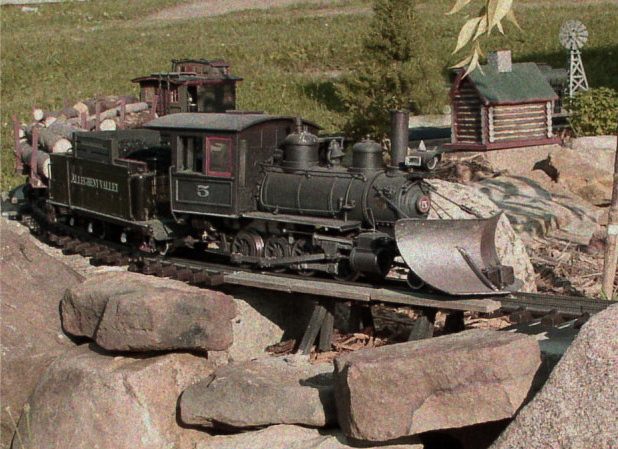
#5 (ex #19) pulls a short log train in the summer of 1948

#5 (ex #19) pulls a short log train in the summer of 1948
The Model: Some years ago I got a fairly good deal on an undecorated 'modern'
Aristo-Craft c-16 at a train show. It ran OK, and pulled
fairly well. However, I was just never really satisfied with it's appearance. The Aristo redesign
of the old Delton model just sits too high, creating a weird angularity in the side rods, and
the tender was just too small. But I had a spare Bachmann cab and
tender from a 2nd Generation big hauler that had trashed it's driveline, so
I decided to see if I could remake my ugly duckling.
About this time I also came across a photo gallery of Thunder Lake Lumber #5 online. It gave me several more ideas for changes.
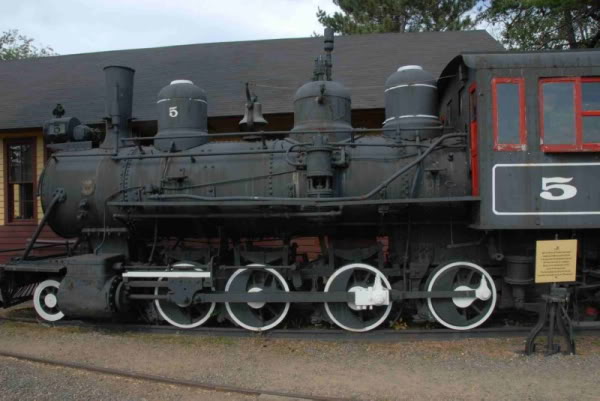
TTL #5 in Rhinelander, Wisconsin
The first order of business was to
remove the old cab and install the B'mann one. The Aristo cab was
re-used on my #6 Stainz bash. The siderods were lengthened to move them
to the third axle as on the Thunder Lake loco. This made the angularity
problem less noticeable. It also received an Ozark Miniatures whistle
and a nice LGB metal bell. The ungainly looking classification lights got replaced
with Ozark smokebox cleanout castings at this time as well.
close up of changes
The Big Hauler tender got
shortened by about 1-1/2", and placed on the Aristo trucks. I also
shortened the coal bunker and added hungry boards and the large tank
from the c-16's tender. The paint scheme was an experiment... it failed
As did the one on the locomotive
under reconstruction in 2009
Cab pictures of the piping from a DRGW c-19 helped me to plumb the cab. My first effort at superdetailing
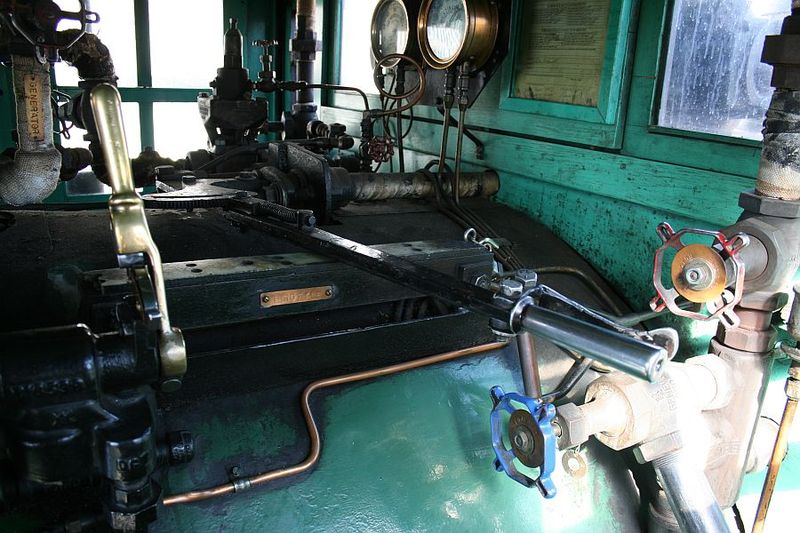
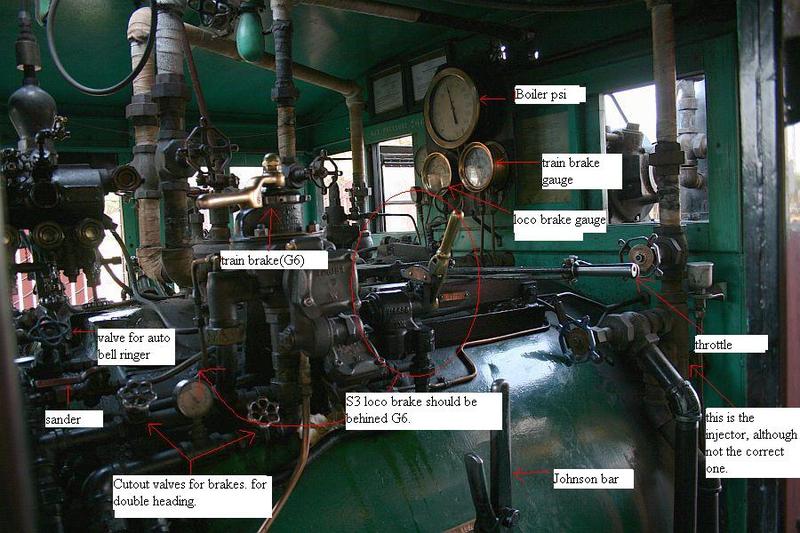
More handmade prototype based plumbing followed. With a plumbed cab, you can't very well just leave the air pumps hanging
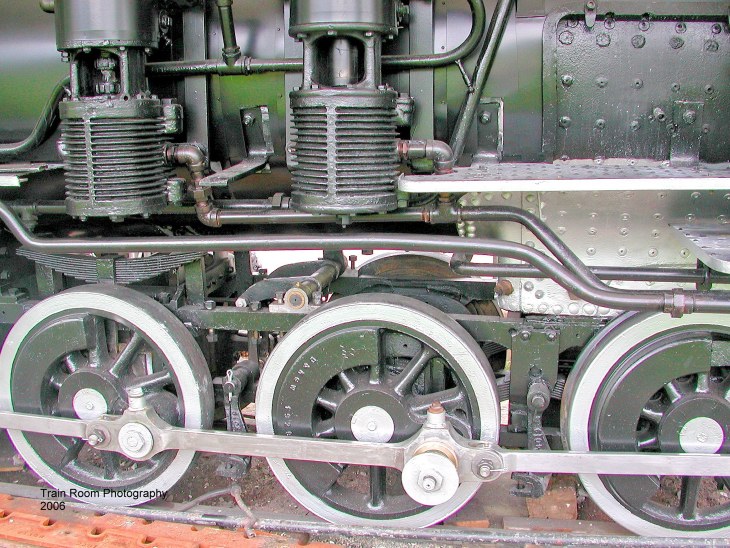
I
also finally decided to simply go with my standard AV scheme, based
upon the GN's 'Glacier Park' -- not that you'll see much of it after
the engine is weathered.
About
this time I also moved the valve linkage back and added the second
crosshead guide bar to match the relocated crankpin. The wheel spacing
is wrong, but we are going to live with it.
Never
one to leave well enough alone, I found this pilot plow from a vendor
in Canada. It changes the whole character of the model.
Painting
on rust. lime and boiler scale in preparation for weathering . A MoW
engine doesn't get much attention, but modeling one takes extra... go
figure.
Say goodbye pretty paint! First we lightly dust with rattle can brown primer overspray, then grey primer, then flat black
Pulling
a log train on the freshly built outdoor AV in June of 2010 (not 1948)
The tender got weathered to better match the loco later that evening.
An Ending - #5 would leave the AVRR roundhouse for the last time in mid-December of 2010 headed for a new assignment in Southern California. We wish her new owner joy!
Thanks for looking!
Go back to the Allegheny Valley